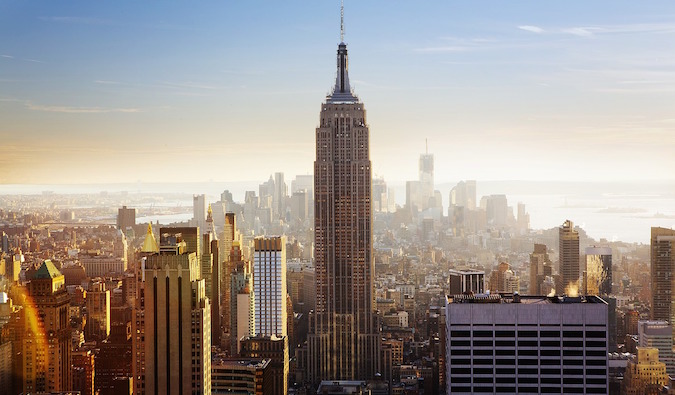
Updated: 05/18/2019 | May 18th, 2019
New York City has been my home for close to three years, though I’ve been coming to the city since I was 16.
(Little known nerd fact: My parents took my friend Matt and me to NYC because we won a free trip for placing first (me) and second (him) in the Massachusetts state championship of the card game Magic: The Gathering. Yes, you read that correctly!)
As you probably know, NYC is one of the best foodie cities in the world — you can find cuisines from every ethnicity here. And from dollar pizza slices to expensive $400 USD meals at Per Se, it also has food to cover all price ranges.
Because of the variety and quality of food here, I rarely cook at home (kitchens are small and there’s better food everywhere!), and so, over the years, I’ve developed a robust list of recommended restaurants that I want to share with you now.
My 25 Favorite Restaurants in NYC

1. Corner Bistro (331 W. 4th Street)
World-famous for its thick and greasy hamburgers, I think this is one of the best burger joints in the city. This tiny, dimly lit bar is definitely not the restaurant you would expect to find such mouthwatering food. I bet they haven’t cleaned the grill in ages, which makes the burgers have such an amazing taste. I’m sure the drinks here are good too but I only ever come for the burger.
2. The Fat Radish (17 Orchard Street)
With some of the best farm-to-table, organic food in the entire city, the menu here changes based on seasonality, offers lots of vegetarian options, and will leave you full and feeling healthy.
3. Hot Kitchen (104 Second Avenue)
Delicious, fiery Szechuan food at a great price. This isn’t the place to get General Tso’s. It’s the real deal. Try the tripe (pig’s intestine) – it’s delicious! Be warned though: the food here is really spicy! Since I’m a wimp when it comes to spicy food, my stomach still suffers the day after I eat there, but if you love fiery food (or are willing to suffer the consequences), don’t miss this place.
4. Jeffrey’s Grocery (172 Waverly Place)
Located in the West Village, this is not a cheap meal (most mains are $20 USD), but they pour heavy, heavy glasses of wine and have some of my favorite oysters and seafood in the city. They also host a $1 USD oyster happy hour on their entire selection (4–6pm during the week), which I think is the best deal in the city!
5. Miss Korea BBQ (10 W. 32nd Street)
This is my favorite Korean BBQ restaurant in the city. Granted, I’m not a Korean BBQ expert, but the meat here is delicious, and they give you a TON of sides of a dizzying variety (which to me is the best part of Korean BBQ. Bring on the unlimited kimchi!). The fact that it’s usually full of Koreans is something I take as a good sign.
6. SriPraPhai Thai Restaurant (64-13 39th Avenue, Flushing, Queens)
The best and most authentic Thai restaurant in New York. As someone who has lived in Thailand, I rarely find a place I like. It’s never as good. I hardly ever get Thai food because I’m always disappointed but this place is the real thing. It’s as close to getting to eating in Thailand as you can get. I especially like the som tam (papaya salad) here. It’s legit.

7. Tomoe Sushi (172 Thompson Street)
This tiny restaurant serves big cuts of fish on perfectly warmed rice. Their toro(fatty tuna) is outstanding. Tomoe is considered one of the best sushi bars in the city and gets packed quickly, so come early or for lunch. Prices here aren’t on the cheap side, but their $18 USD lunch set offers the best value.
8. Yuba (105 E. 9th Street)
My favorite sushi bar in the city, this little restaurant is easily missed. I visit here too often — so often they gave me cake on my birthday and call me up when they have hard-to-get or especially fresh fish. I take all my friends here. It’s consistently the best sushi I’ve found for the best price. Try the lemon roll (you have to ask for it, it’s not on the menu), the toro, and the uni. Tell Jack and Nina that I sent you.
9. Russ & Daughters (179 E. Houston Street)
This is the best breakfast and brunch joint in the city, hands down. Nothing even comes close. Come here for latkes, lox plates, world-class cream cheese, and anything else breakfast/deli like you can think of. There are two sections: the restaurant and the deli. The restaurant always has a long, long wait, so if you don’t get there early, it’s better to grab from the deli around the corner and eat elsewhere.
10. Left Bank (117 Perry Street)
Located in the West Village, this French restaurant offers a wonderful $20 USD Sunday prix fixe dinner that is one of the best budget meals in the city. You get two courses and wine in a romantically lit setting. My roommates and I also come here often, especially if we want a nice quiet bonding evening!
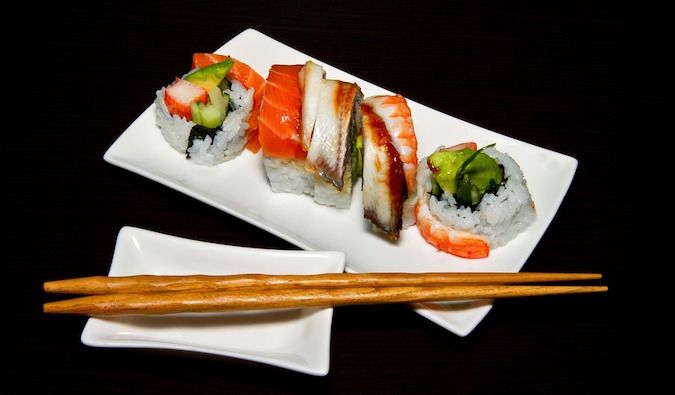
11. Sao Mai (203 1st Ave)
A great Vietnamese place located near my apartment, this place serves pho that rocks my world. The portions are huge here and, according to my friend Jodi, who is an expert in all food Vietnamese, this place is authentic.
12. S’MAC (345 E 12th St)
A mac-and-cheese shop that takes the traditional dish and makes it even better. It’s heavenly, cheesy goodness. Their 4-Cheese and Cheeseburger are my two favorites. The fact that this place is around the block from my house has become a problem, though — I’m eating there too often and may be getting a S’MAC belly!
13. Masala Times (194 Bleecker St)
I was only recently turned on to this place near the NYU campus. Serving Bombay-style street food, this place serves some really good Indian meals. I couldn’t get enough of it. The plates are sharable, and you get rice and bread, too. Try the Fish Tikka — it’s delicious.
14. Vanessa’s Dumpling (220 E 14th St)
I stumbled upon this place in the East Village while walking home one day; it was only later that I found out it’s actually quite famous. After eating their dumplings, it’s easy to see why. They were delicious — the pork dumplings had an intense flavor to them. And at 10 for $2, the price is just right.
15. Prosperity Dumplings (46 Eldridge St)
Located in Chinatown, this is another amazing dumpling place. The pork dumplings come fried or steamed, and there’s a nearby park where you can sit if this tiny place is full. And if you want more for later? You can buy 50 frozen dumplings for $8!

16. John’s on Bleecker (278 Bleecker St)
Pizza in New York is an institution, and I admit I’m no pizza guru. To me, it’s either bad, good or really good. I can’t make those fine pizza distinctions like some New Yorkers can. I qualify John’s as really good. The thin-style pizza comes in huge portions big enough to serve three. Service is quick, but expect to wait for a table during dinner.
17. Chelsea Market (75 9th Ave)
Chelsea Market is more a collection of food places than a single restaurant. It’s extremely popular and a great place to pop into when you need some groceries, a meal, or snacks. You’ll find good Thai food here, and Amy’s Bread has amazing bread. The Lobster Place has decent sushi (and great lobster), but I really enjoy their clam chowder. If you want a meal with local and organic food, try the Green Table.
18. Rosemary’s (18 Greenwich Ave)
This West Village Italian restaurant boasts a rooftop farm with fresh produce and herbs that goes directly into the food you eat. Their handmade pastas are a must-eat and they have a good Rosé selection. It’s one of the best weekend brunch locations in the city too. Come early because it fills up really quickly, especially on nice warm day.
19. Bennie’s Thai Café (88 Fulton St)
As someone who has lived in Thailand, I’m quite picky about my Thai, but this restaurant is legit. It’s a popular lunch spot with the working crowd and serves incredible curry. It’s one of the few locations where I can get an authentic Thai iced tea too! Service is a little too fast and abrupt, but who cares? The food is incredible.
20. Mamoun’s Falafel (119 MacDougal St)
You will find inexpensive falafel and gyro stands all over Manhattan, but the best one is Mamoun’s. You can pick up a classic falafel with tahini and salad for less than $5, but all the options here are tasty and affordable.
21. Karasu (166 Delkab Ave)
This is often considered a restaurant and cocktail bar, but it’s more of an izakaya speakeasy (you’ll need to enter through a secret door). It has an elegant ambiance and the drinks are top-notch. The menu isn’t huge, but everything is delicious.
22. Peter Luger Steakhouse (255 Northern Blvd)
Located in Williamsburg, this is the best steakhouse in the city. It’s an institution in the city. The restaurant has a German beer hall feel and the steak (which they age in-house) is some of the best I’ve had in my life.
23. Eat’s Khao Man Gai ( 518 E 6th St)
This is a tiny restaurant with a limited menu, but the food here is absolutely delicious. Their Thai-style Hainanese chicken and rice is simple but tasty.
24. Friend of a Farmer (77 Irving Pl)
Since 1986, Friend of a Farmer has been embracing the farm-to-table movement, offering seasonal dishes as well as classic comfort food. The food is filling and hearty. They have a great brunch too!
25. Pete’s Tavern (129 E 18th St)
This vintage bar has been open since 1864. It’s an unpretentious place where you can enjoy some pub food and enjoy that classic tavern atmosphere.
After living in the city for years, this list reflects what I think are some of the best and most unique offerings the Big Apple has to offer.
But this is just the tip of the iceberg too. New York City has some of the greatest bars and restaurants in the world and you could spend a lifetime (and a fortune) trying them all.
But don’t take my word for it. Come and put my suggestions to the test and let me know what you think!
NEXT STEP —> Get My Guide and See More of NYC for Less!

You’ll get off the beaten path, away from crowds, and see the local side of New York City visiting my favorite sights, restaurants, bars, and attractions!
Book Your Trip to NYC: Logistical Tips and Tricks
Get Your Guide
Check out my detailed guide to planning a visit to NYC with suggested itineraries, places to stay, things to do, where to eat, and how to get around. Just click here to get the guide and continue planning today!
Book Your Flight
Find a cheap flight by using Skyscanner or Momondo. They are my two favorite search engines because they search websites and airlines around the globe so you always know no stone is left unturned.
Book Your Accommodation
You can book your hostel with Hostelworld. If you want to stay elsewhere, use Booking.com as they consistently return the cheapest rates for guesthouses and cheap hotels. I use them all the time. My favorite places to stay in the city are:
- Q4 (Queens) – This is a recently-renovated hotel/hostel property with basic rooms, comfy beds, and the common room has a pool table and table tennis. There’s a small kitchen for cooking too. It’s a great launching pad to explore one of the best food neighborhoods in town!
- Broadway Hotel and Hostel (Upper West Side) – This hotel/hostel is close to Central Park and is a nice place to just hang out. They screen movies, have a library, a lounge, and a kitchen as well. If you’re looking for a comfortable place in a more relaxed environment, this is one of the better hostels in town.
- NY Moore Hostel (East Williamsburg) – Located in the trendy neighborhood of East Williamsburg, this hostel is covered in artwork and graffiti, which makes it super quirky and beautiful. The beds are average, but it’s a cozy hostel to stay at and they have free parking too!
Don’t Forget Travel Insurance
Travel insurance will protect you against illness, injury, theft, and cancellations. It’s comprehensive protection in case anything goes wrong. I never go on a trip without it as I’ve had to use it many times in the past. I’ve been using World Nomads for ten years. My favorite companies that offer the best service and value are:
- World Nomads (for everyone below 70)
- Insure My Trip (for those over 70)
Looking for the best companies to save money with?
Check out my resource page for the best companies to use when you travel! I list all the ones I use to save money when I travel – and I think will help you too!
Photo credits: 2, 3, 4, 6, 9, 13
3, 5, 6, 7, 10, 12, 14
The post 25 Delicious Places to Eat in NYC (A list of My Favorites) appeared first on Nomadic Matt's Travel Site.
Everything is F*cked: Reflections on Hope and Travel with Mark Manson
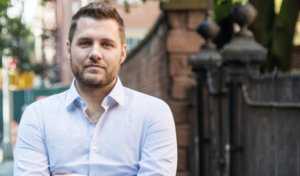
Posted: 05/14/2019 | May 14th, 2019
You meet a lot of interesting and smart people when you run an online business and travel the world. One of the people I’ve met is best-selling author Mark Manson. We had orbited each other for many years and finally met when he moved to New York City.
We’ve been “real life” friends ever since.
His first book, The Subtle Art of Not Giving a F*ck, became a runaway hit, selling over 8 million copies. (He wrote a post about how travel made him the person is today, which laid the foundation for that book.)
Now, Mark has a new book out today called, Everything is F*cked: A Book About Hope. I received a copy to read in advance and it’s a really incredible book about philosophy and how to live a life of meaning and challenge in our modern times. It gave me some good food for thought about issues or perspectives I hadn’t thought about before.
Today, Mark and I chat about his new book!
Nomadic Matt: You have a new book out, Everything is F*cked: A Book About Hope. Let’s talk about it. What would you say the core of this book is about?
Mark Manson: At its heart, this book is a look at how to develop and maintain a sense of hope for ourselves and the world — and how these hopes affect us. We generally see hope as an unequivocally “good” thing, but I call that idea into question in this book.
Would it be a considered follow up to The Subtle Art?
I’ve been calling it an “expansion” of the ideas from Subtle Art. I think it’s a deeper analysis and more complex application of the same concepts—values, pain/suffering, and our definitions of success. It’s kind of like the calculus to Subtle Art’s algebra or the chess to its checkers.
What inspired you to write this book?
Well, just looking around at what is going on in the world. We’re living in a weird time in that materially, the world, as a whole, is the best it’s ever been (less poverty, violence, more wealth, people living longer, etc.), yet mentally and emotionally, people are struggling more than ever with finding hope and meaning in their lives.
And what’s interesting is that it’s the people from the wealthiest and most stable parts of the world who are experiencing these philosophical struggles the most.
On top of that, I’ve noticed in my own life, that as an older millennial, all the promises of my youth have turned out pretty ugly. From the internet to my country and to my assumptions about relationships, friendships, community, it feels like there’s a lot to be justifiably upset about — yet things are objectively better.
I’ve had my own struggles with finding meaning and hope in my own life, despite the fact that, on paper, everything is awesome. So, in that way, this book is kind of my own way to sort through these issues.
Since this is a travel website, let’s talk about your book and travel. How can travel make us less f*cked? Or can it?
I think anything that increases human empathy is hugely important and beneficial at the moment. I also think anything that can cause you to confront your own value systems and question them is incredibly useful.
Travel does both of those things very well.
It’s a bit ironic that by connecting the world more than ever before, we’ve also come to objectify cultures more than ever before. Everything is about “the ‘Gram” so to speak. I think a highly conscious and culturally engaged form of travel is still paramount.
Like anything, travel can become an escape from one’s problems rather than a pursuit of some higher understanding. So, it’s important to always make sure you’re on the right side of that equation.
One aspect of the book I found really interesting was the formula for life and how it relates to being a better person (especially in relation to travel). Can you describe this idea a little bit?
The Formula of Humanity comes from the philosopher Emmanuel Kant and essentially says that the driving force behind all of our decisions and actions should always be people. That more than emotions, more than culture, more than group loyalties, our first principle should always be to treat people (both ourselves and others) with dignity and respect.
And I think travel forces one to practice this.
It’s easy to sit on one side of the world and criticize people on the other. But when you go there and discover that 99% of the people are good, decent people and actually value the same things you do, it makes empathy more possible.
What can people learn from your book that they can apply to their lives?
I think there are five points that people can really apply to their own life:
- Why self-discipline requires understanding your own emotions.
- Why trauma and loss cause emotional dysfunction and how we can overcome that dysfunction.
- How every belief system is ultimately a little bit religious and we need to be careful about that.
- How to be more resilient.
- How to be freer in a world of constant distraction and diversion.
You talk a lot about how our feelings brain being in control and that we live in a feelings economy, where emotions run rampant. Can travel temper that in any way? Can travel show us how not to be keyboard warriors?
Unfortunately, there’s no way to NOT be irrational and emotional, as much as we’d sometimes like to. The key is to not resist or attempt to change our emotions but simply work with them, rather than against them. Things like anger, anxiety or even despair can be highly useful if channeled properly. The key is to develop the skill-set to channel them.
I think like a lot of things, travel amplifies who you already are. If you’re selfish and intolerant, then your travel experiences will reflect that. If you’re magnanimous or curious, then they will reflect that. A way that travel can be useful is that it is a tool to force you to work on aspects of yourself that you wouldn’t otherwise be able to work on.
Do you struggle with being alone or caring too much about what others think? Travel alone.
Used to being pampered and upset over every little thing? Go take a train through the Indian countryside. That’ll straighten you out real quick!
You mention a lot of philosophers in your book (which I enjoyed because I got a lot of book suggestions). What are some good books to read around this topic?
It’s exciting because I feel like philosophy is becoming cool in our culture. It makes sense because as all of our basic needs are taken care of, these questions of existential meaning, purpose, and what to hope are more at the forefront of our minds, and those are all philosophical questions.
If you’re a complete newbie to philosophy and want to get a basic understanding of the Western canon, I recommend a book called Sophie’s World by Jostein Gaarder. It’s a fun fiction book that acts as kind of a primer to the most important western thinkers.
If you’re into eastern philosophy, DT Suzuki’s books are a nice introduction to Zen Buddhism. The Tao Te Ching is highly readable and thought-provoking. And Alan Watts’ books are indispensable.
And if you want to see how applications of ancient philosophy are incredibly useful in today’s world. Check out Jonathan Haidt’s The Happiness Hypothesis or Ryan Holiday’s The Obstacle is the Way.
You talk about how we need pain to grow and, I think, part of experiencing pain is getting out of your comfort zone. What can travel teach us about pain and growth?
Painful travel is the best kind. It’s like going to the gym for your mind and your understanding of humanity. My first trips to India and Africa were two of my most difficult and uncomfortable trips and today I think back to them fondly because they were incredibly formative to my understanding of the world.
India was shocking because of the quantity of beauty and human suffering squished into such confined spaces. You could see one of the most beautiful things in your life and one of the most horrific things in your life, all within a few blocks of each other.
Africa was eye-opening because when you really get out in the bush, you get a real sense of how little humans need to be happy. It’s cliché to say that money and possessions don’t make you happy, but when you see with your own eyes people who are feeling just fine owning nothing more than a goat and a robe, it’s quite profound.
China was probably the most alienating place I’ve ever been. I’ve never felt so foreign in my life. It’s the only place I’ve been where I’ve really gotten the sense that I did not matter, at all. And just having to sit and live with that feeling for the two weeks I was there was quite impactful.
I think it’s easy to forget how resilient the human spirit is, how many places it can flourish, and how easily it can be happy. The first time you see a child shit on the side of the street, it suddenly grants a lot of perspective the next time you complain about bad Wi-Fi.
Ultimately, I argue that a growing issue in the world today is that we aren’t challenged enough and that we don’t have meaningful struggles, so we have to invent meaningless ones to take their place and maintain a sense of hope.
Travel is a way to constantly challenge yourself. Whether it’s traveling to a poor country or forcing yourself to study a language or physically testing yourself through hikes and biking across continents. It’s indispensable.
Finally, in your own words, why should people buy this book?
Because it’s fucking awesome! And, as with my last book, I utilize stories and examples from all over the world and from a number of different cultures to make my point.
There’s a soldier from Poland and a monk from Vietnam and historical fiction about Isaac Newton and a vignette about Friedrich Nietzsche and his over-sized mustache. What’s not to love?
(Matt says: And it really is great like he says! Pick up a copy, especially if you enjoyed his last one!)
 Mark Manson is a blogger, entrepreneur, and the best-selling author of The Subtle Art of Not Giving a F*ck, which has sold over 8 million copies worldwide. He specializes in writing personal development advice that doesn’t suck. His website MarkManson.net is read by over 2 million people each month.
Mark Manson is a blogger, entrepreneur, and the best-selling author of The Subtle Art of Not Giving a F*ck, which has sold over 8 million copies worldwide. He specializes in writing personal development advice that doesn’t suck. His website MarkManson.net is read by over 2 million people each month.
His new book, Everything is F*cked: A Book About Hope is now available. He lives in New York City.
Book Your Trip: Logistical Tips and Tricks
Book Your Flight
Find a cheap flight by using Skyscanner or Momondo. They are my two favorite search engines because they search websites and airlines around the globe so you always know no stone is left unturned.
Book Your Accommodation
You can book your hostel with Hostelworld as they have the largest inventory. If you want to stay somewhere other than a hostel, use Booking.com as they consistently return the cheapest rates for guesthouses and cheap hotels. I use them all the time.
Don’t Forget Travel Insurance
Travel insurance will protect you against illness, injury, theft, and cancellations. It’s comprehensive protection in case anything goes wrong. I never go on a trip without it as I’ve had to use it many times in the past. I’ve been using World Nomads for ten years. My favorite companies that offer the best service and value are:
- World Nomads (for everyone below 70)
- Insure My Trip (for those over 70)
Looking for the best companies to save money with?
Check out my resource page for the best companies to use when you travel! I list all the ones I use to save money when I travel – and that will save you time and money too!
The post Everything is F*cked: Reflections on Hope and Travel with Mark Manson appeared first on Nomadic Matt's Travel Site.
How to Get Around Central America on a Budget
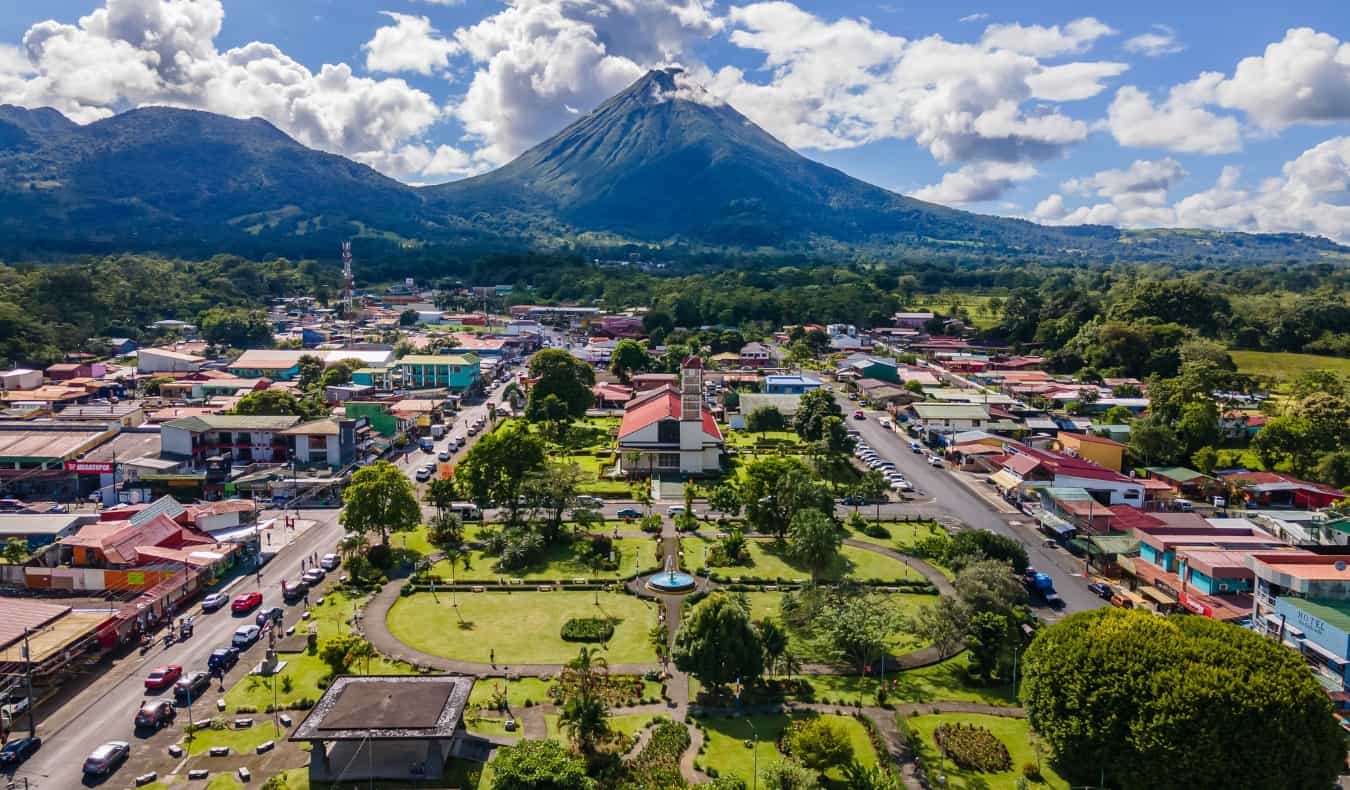
Surrounded by the Pacific and Atlantic Oceans, Central America is a magical region that is perfect for backpacking. The area is full of rainforests, unexplored Mayan ruins, gorgeous beaches, incredible reefs, cheap prices, delicious food, and welcoming people.
It can be difficult arranging transportation throughout the region.
In this post, I’ll provide some helpful tips on getting around Central America so you can navigate the region safely — and without breaking the bank.
Here’s how you can travel around Central America cheaply – no matter how long you’ll be there:
Table of Contents
Getting Around Cheap By Bus
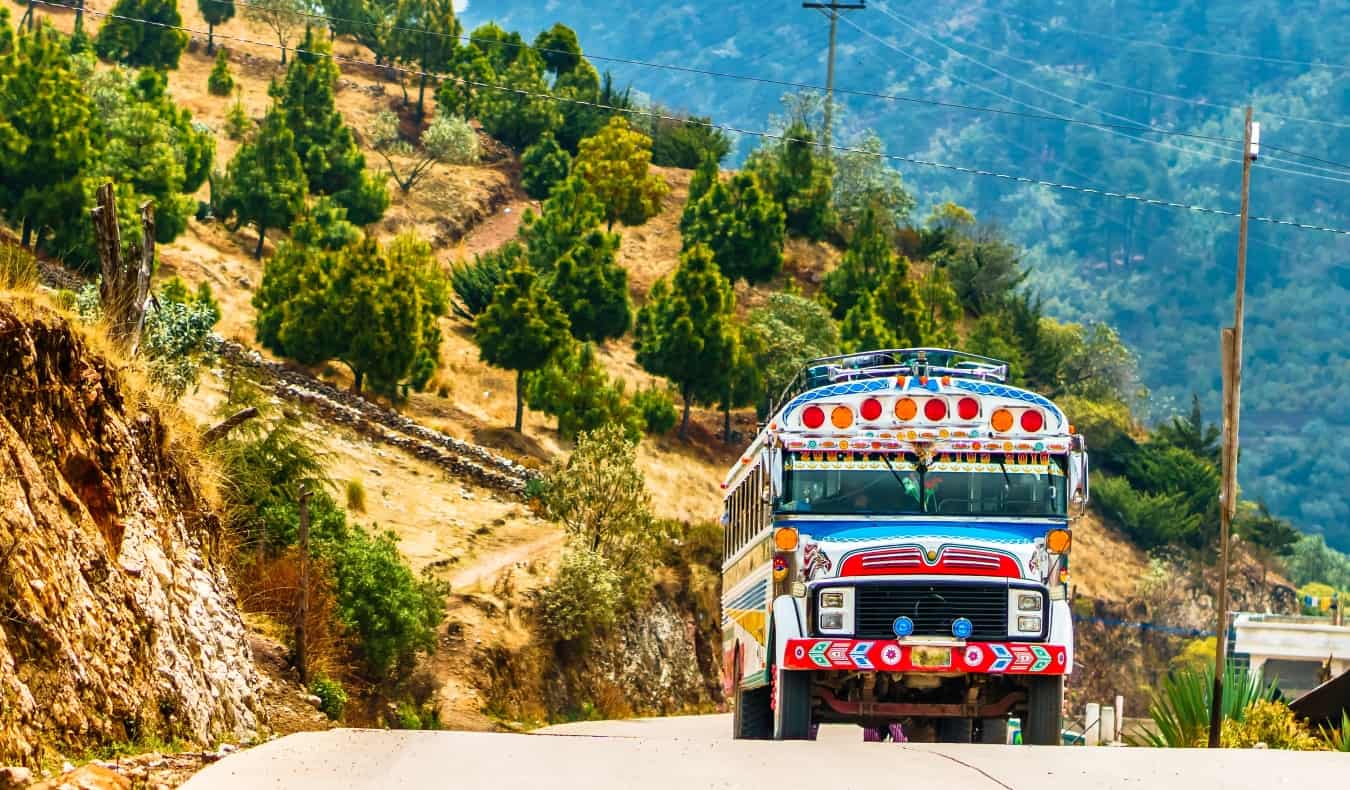
Buses are the main form of transportation that you’ll use to get around Central America. In fact, it’s about the only way to get around Central America as there are no train lines and regional flights are expensive. You’re going to take buses most of your trip.
There are several different kinds of buses in the region. The most comfortable are the international buses that run between the larger cities and tend to have their own bus terminals. They have set, reliable schedules and are best for long distances. They make traveling easy and even take care of the hassles at border crossings. The companies you use might vary by country, but a few of the larger services include:
Here are some approximate fares and journey durations for express bus routes in Central America (in USD):
- Belize City to Flores – $30 (6 hrs)
- Flores to Guatemala City – $28 (8 hrs)
- Guatemala City to San Salvador – $25 (6 hrs)
- San Salvador to Tegucigalpa – $35 (9.5 hrs)
- Tegucigalpa to Managua – $30 (6 hrs)
- Managua to San Jose – $30 (7.5 hrs)
- San Jose to Panama City – $80 (16 hrs)
- San Salvador to Antigua – $30 (6 hrs)
- San Jose to Tamarindo – $18 (4 hrs)
- San Jose to Boquete – $20 (9 hrs)
The routes are often straightforward, the buses are air-conditioned, there’s a bathroom on board, and the seats recline. Some companies have partnerships with local hotels/hostels so that you get dropped off right at the door rather than having to find your way in the middle of the night upon arrival.
While most of these bus services have websites, they’re often extremely buggy and difficult to use. To compare routes and prices, you can research your journey on Rome2Rio.com before either booking on the bus company’s website or simply showing up at the terminal to purchase your ticket.
For short distances, there are colectivos. This short-distance minivan service is super cheap, but often very crowded. You’ll usually find them at bus terminals, so it’s worth checking with the drivers to see where they’re going.
Finally, there is the local chicken bus. These colorfully painted vehicles were formerly U.S. school buses. They are called “chicken buses” because they also transport chickens and rice, and thus have a lot of chickens on them. It’s a nickname that has stuck among travelers. They stop just about everywhere to let people hop on and off. They are a cramped but fun and interesting way to get around places. I always end up meeting interesting folks on chicken buses.
Getting Around Cheap By Flying
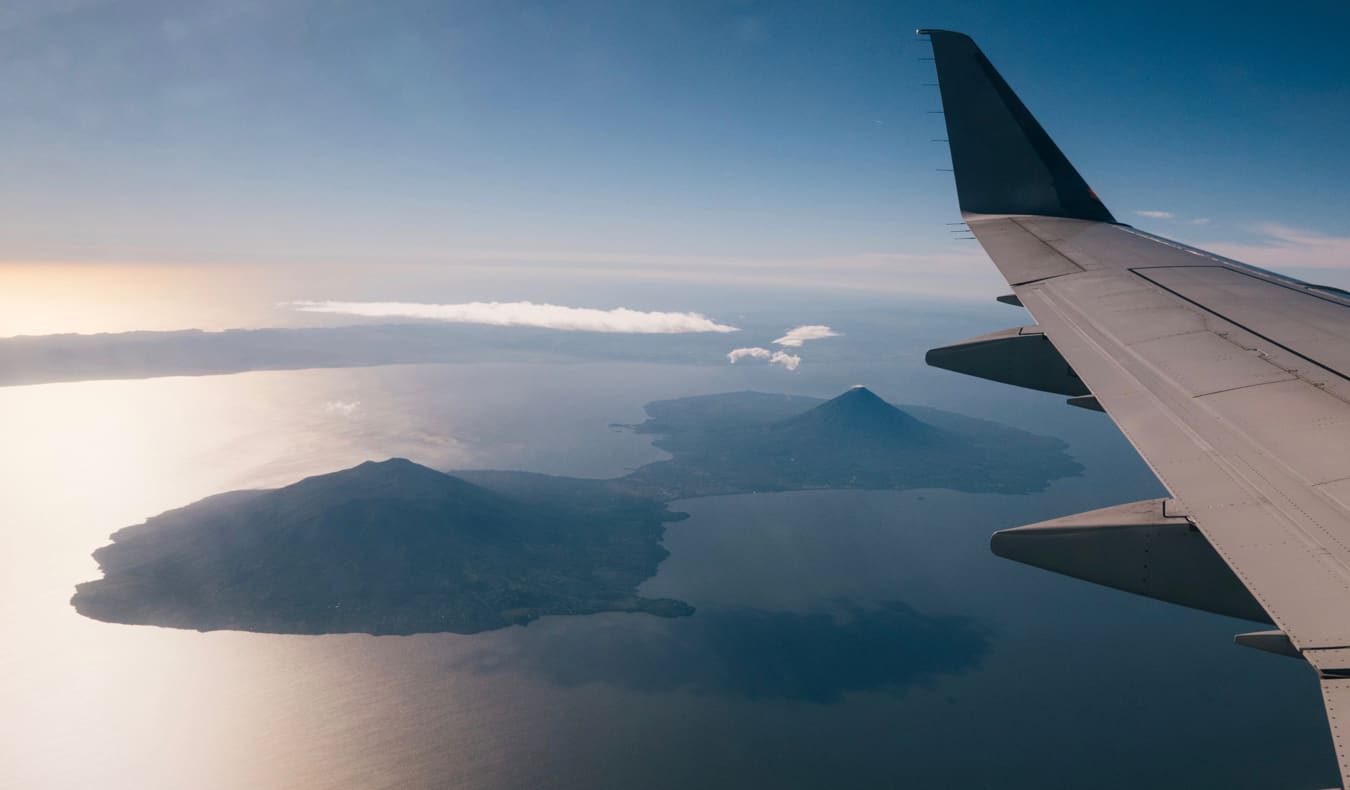
Flying isn’t the cheapest way to see Central America (and routes are really limited).There is a limited regional air network in this region. The biggest operator is Copa Airlines, which is based out of Panama. The Colombian airline Avianca offers some direct flights between big cities in Central America, and the Guatemala-based TAG flies directly to a few other destinations in the region.
Outside of the capital cities and any international airports, the airports tend to be very small and only accommodate small propeller planes. Most of those small airlines have dubious safety records and I try to avoid them as much as possible.
Here are some sample non-stop flight times and one-way ticket prices (USD):
- Guatemala City to Belize City – $200 (1 hr 15 min)
- Guatemala City to San Salvador – $60 (45 min)
- Flores to Guatemala City – $50 (1 hr)
- Managua to Panama City – $765 (1 hr 40 min)
- San Jose to Panama City – $370 (1 hr 20 min)
- Managua to San Jose – $370 (1 hr 15 min)
- San Pedro Sula to San Salvador – $80 (50 min)
Note: If you book early, you can save on fares. Fares also vary depending on the time of year.
Use Skyscanner to find cheap flights around the region.
Planning a trip to CENTRAL AMERICA?
Get all my best travel tips along with these FREE planning guides:
- My Favorite Companies to Use
- 61 Savvy Travel Tips
- 16 Steps for Planning a Trip
- How to Get Free Flights
Enter your info below to get everything sent to you right away:
Getting Around Cheap By Car
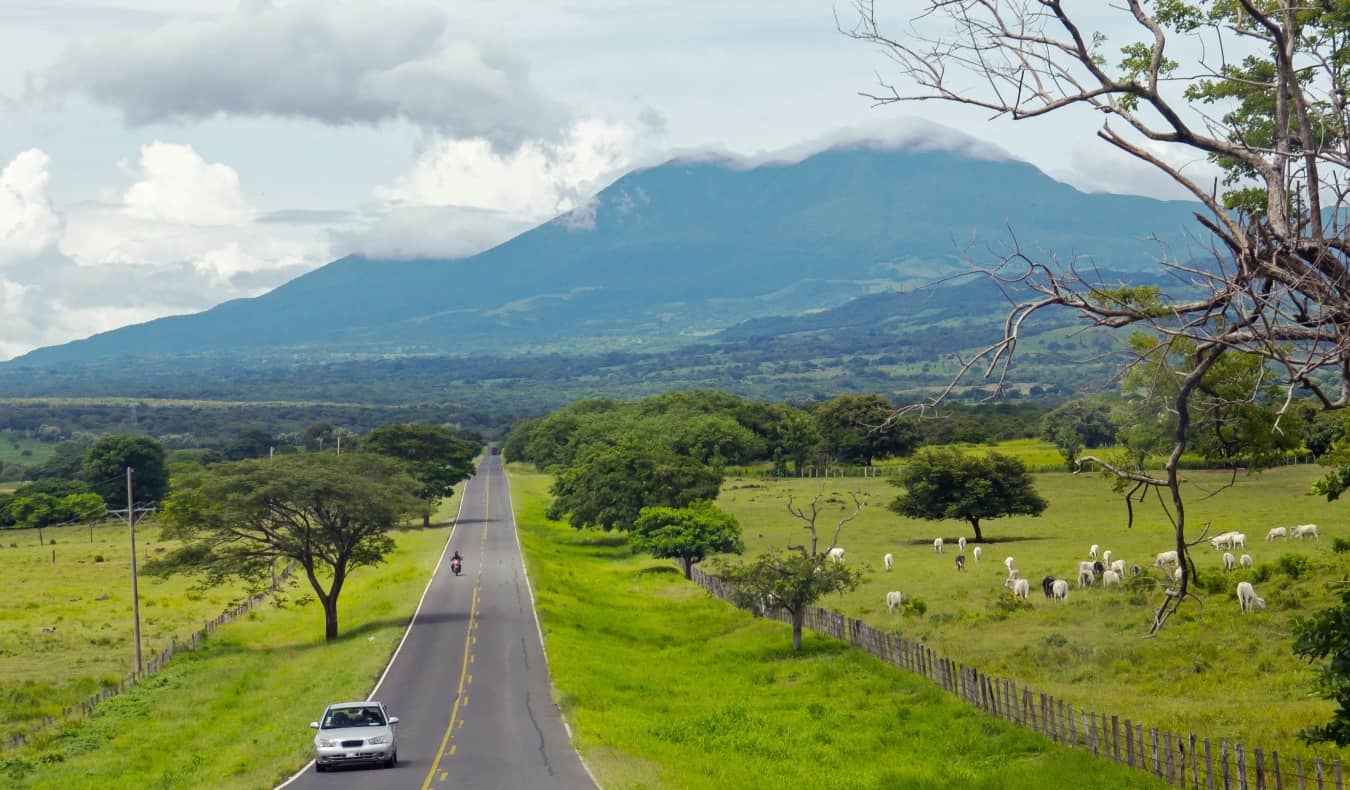
Having your own vehicle allows you to save time getting around while also giving you the flexibility to stop off wherever strikes your fancy along the road. Lots of people drive through the region, either with a rental car or with a car or van they bought elsewhere. Renting a car and driving around Central America has become a lot cheaper as rental car prices have come down in recent years. If you’re traveling with others (which could very well be new friends that you just made in your hostel), it can be a very affordable way to travel.
Just keep in mind that not all car companies allow you to drive their vehicles across borders, so this can sometimes be a tricky option depending on what countries you plan to travel through. However, renting a car can be a great way to explore one country more in-depth.
If you plan on exploring the region by car, you should be a confident driver. Roads are not always in the best condition and rules of the road can be more like loose suggestions. Always make sure to take common safety precautions too, such as never leaving valuables in the car, not driving at night if you can avoid it (this greatly increases your risk of carjacking), and being mindful of general safety in the areas through which you plan to drive (ask locals in advance for tips about your planned route).
Use Discover Cars to find the best rental car prices as it pulls data from over 8,000 car rental locations to ensure you always find a great deal.
Getting Around Cheap By Boat
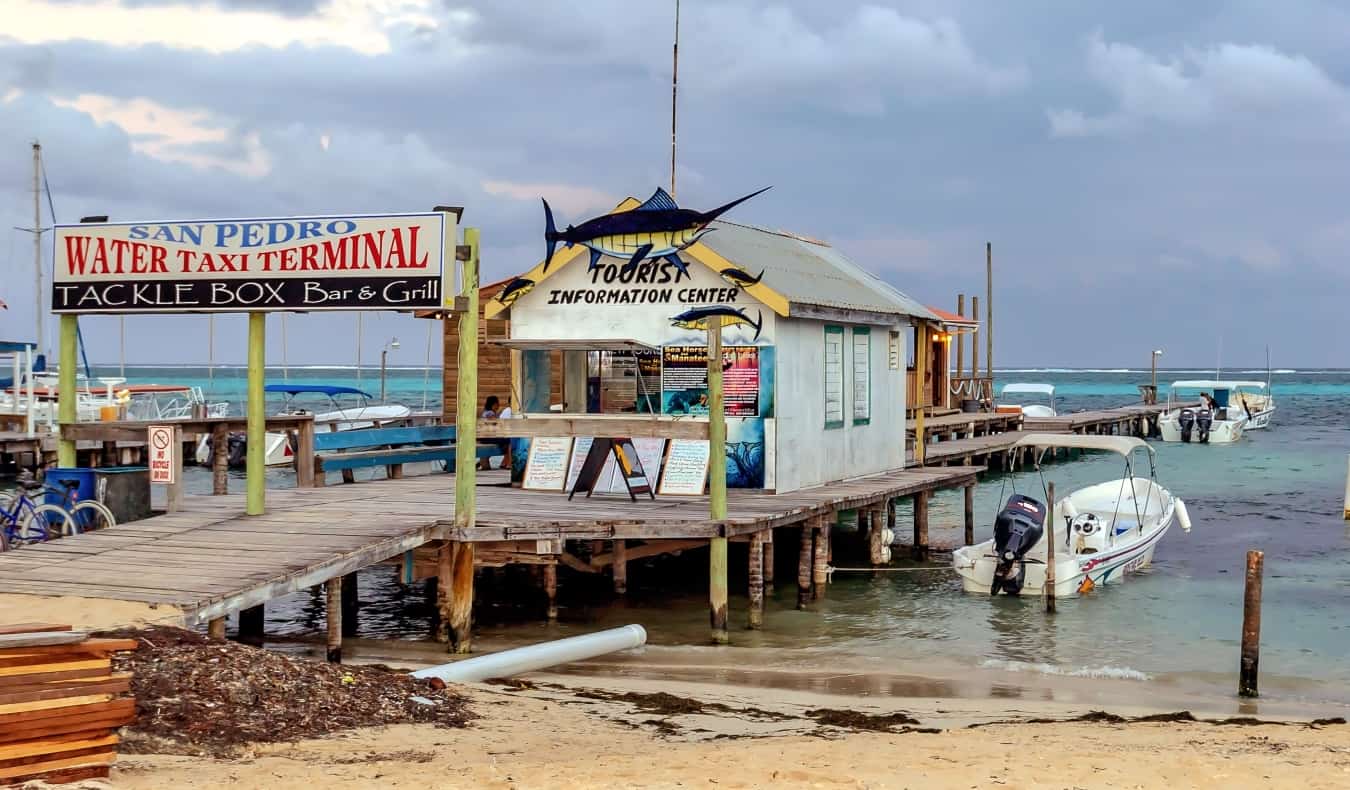
If you want to visit islands or coastal towns, boats and ferries are options to consider. You can find ferries and book tickets on DirectFerries.com (which searches thousands of local operators so you don’t have to).
In Belize, ferries to the islands are typically $35-45 USD and the main operators are Caribbean Sprinter and Ocean Ferry Belize. You can reach Honduras’ Bay Islands (including Roatan) by ferry, and you’ll definitely want to take a boat trip if you’re heading to the Corn Islands.
If you are traveling from Belize to Guatemala, there’s a water taxi from Punta Gorda to Puerto Barrios. And there’s a service from Belize (Placencia or Belize City) to Honduras (Puerto Cortes).
Here are some sample ferry durations and fares (in USD):
- Belize City to Ambergris Caye (1.5 hrs) – $42 (one way), $57 (round trip)
- Belize City to Caye Caulker (45 min) – $36 (one way), $45 (round trip)
- Ambergris Caye to Caye Caulker (30 min) – $36 (one way), $45 (round trip)
- La Ceiba to Roatan (1 hr 15 min) – $40 (one way), $71 (round trip)
For short journeys (like between the Corn Islands or to various towns on Lake Atitlan), it’s easiest to just show up and hire a boat or water taxi to take you across. Prices are usually negotiable this way.
Getting Around Cheap By Train
Trains are not an available method of travel in Central America. Though there are some freight trains that move cargo in the region, you won’t find a passenger train network in any country (Belize doesn’t even have a train line of any kind). If there are trains, they usually run from the capital to one other major city and are generally commuter trains.
How Long Does It Take to Get Around Central America?

Getting around Central America can definitely be a bit tedious from time to time. Buses can be slow and don’t always depart or arrive on time. They will often wait until they are full and stop and pick up people on the way or for rest breaks.
But, to help you plan, here is a distance and time chart so you know (roughly) how long it takes to get from place to place in Central America:
– Belize City
– San Salvador
Guatemala City
Central America is an amazing place – though getting around the region will take some planning and research.
Things won’t always go smoothly and getting from place to place here can sometimes be a hassle. But with a little preparation and a pinch of patience, you’ll be able to have an amazing experience.
Be flexible with your schedule. Make sure you plan ahead. Do that, and you’ll be able to enjoy this incredible region of the world!
Plan your trip to CENTRAL AMERICA like a pro
Get all my best travel tips as well as my FREE planning guides sent straight to you and see more of the region for less!
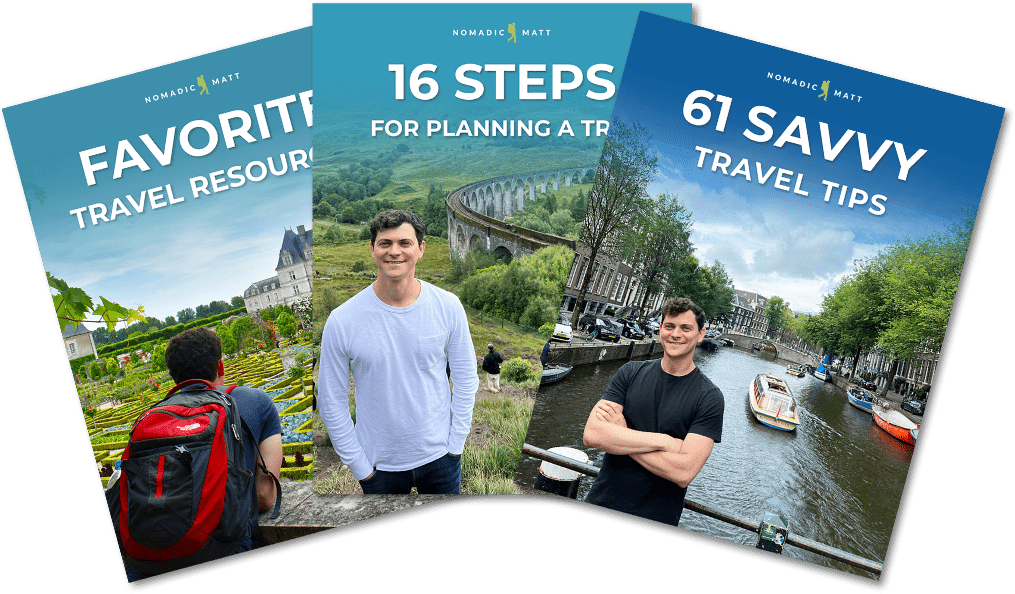
Book Your Trip to Central America: Logistical Tips and Tricks
Book Your Flight
Use Skyscanner to find a cheap flight. They are my favorite search engine because they search websites and airlines around the globe so you always know no stone is left unturned.
Book Your Accommodation
You can book your hostel with Hostelworld as they have the biggest inventory and best deals. If you want to stay somewhere other than a hostel, use Booking.com as they consistently return the cheapest rates for guesthouses and cheap hotels.
Don’t Forget Travel Insurance
Travel insurance will protect you against illness, injury, theft, and cancellations. It’s comprehensive protection in case anything goes wrong. I never go on a trip without it as I’ve had to use it many times in the past. My favorite companies that offer the best service and value are:
- Safety Wing (for everyone below 70)
- Insure My Trip (for those over 70)
- Medjet (for additional repatriation coverage)
Looking for the Best Companies to Save Money With?
Check out my resource page for the best companies to use when you travel. I list all the ones I use to save money when I’m on the road. They will save you money when you travel too.
Want More Information on Central America?
Be sure to visit my robust destination guide on Central America for even more planning tips!
The post How to Get Around Central America on a Budget appeared first on Nomadic Matt's Travel Site.
Can Introverts Successfully Travel Solo?

Posted: 5/2/2019 | May 2nd, 2019
Kristin Addis from Be My Travel Muse writes our regular column on solo female travel. It’s an important topic I can’t adequately cover, so I brought in an expert to share her advice for other women travelers to help cover the topics important and specific to them! In this month’s article, she shows us how solo travelers can deal with traveling as an introvert!
Recently, I traveled to Oakland to attend a birthday brunch. I didn’t know anyone besides the birthday girl. As an introvert, situations like that are hard for me; I don’t like strangers.
Per usual, I was pretty uncomfortable at first, choosing to stick close to the one person I knew and to kill time by slowly pouring myself a coffee and eating a fruit plate at tortoise speed.
But, as time passed, I began conversing with one new person, then another, and then almost everyone who was there. I met truly interesting and friendly people, and by the end of it, I was so glad that I went and that I stayed.
When I’m at home, though, I tend to put off going out to do simple things that involve personal interactions, like grocery shopping, until the last minute. It can get pretty ridiculous, to be honest.
Yet on the road it’s so much easier to get out and explore and especially to meet new people. Why is that?
In a word: dopamine.
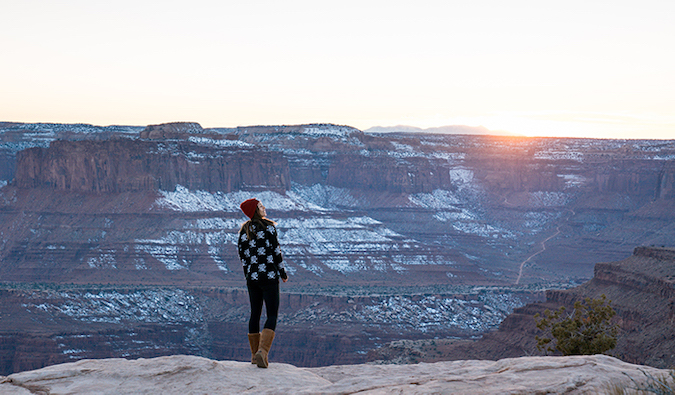
According to professors Daniel Z. Lieberman and Michael E. Long in The Molecule of More, dopamine, which plays a major role in reward-motivated behavior, is what pushes us to try new things. In addition, researchers Nico Bunzeck and Emrah Düzel found, through MRI scans, that the reward center of our brain is stimulated more by novelty than familiarity.
Therefore, we are hardwired to explore and crave newness. It’s the anticipation of the unknown — and how exciting it could be — that encourages us to go beyond our comfort zones.
So, while it can be difficult for introverts to approach people and venture outside to do routine things at home, where everything is familiar, when we’re on the road we have dopamine on our side.
This scientific explanation makes sense to me. When I’m traveling and experience a moment of true novelty, I feel like I’m riding a natural high, something more pleasurable than I could ever try to manufacture. Newness feels good, so traveling feels good, and being an extrovert in these moments comes naturally.
So just know that even if you tend to be shy and uninterested in going to random house parties or even the grocery store at home, you may find that you have renewed energy for meeting people (and feeding yourself) on the road. It helps tremendously that most other people are also feeling that dopamine rush from traveling, so they’re in a more approachable state, too.
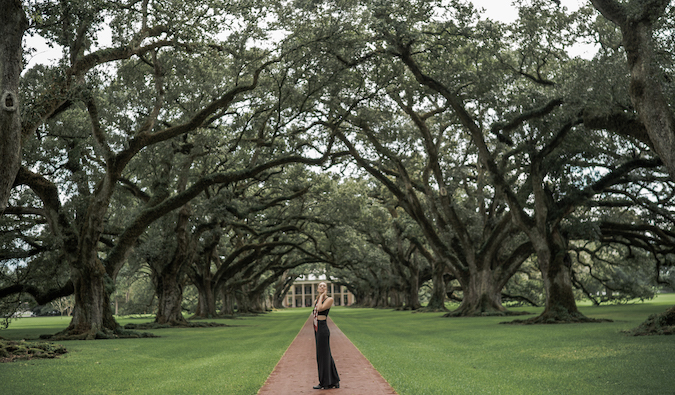
I used to joke that at home in Southern California I had no idea how to make new friends. Do I just walk up to them at a café and ask what they like to do during their free time?
The truth is, on the road, the answer is “yes.” It’s often that simple. Travelers are by and large more receptive and friendlier than most of us are probably used to back home. Since we’re all getting dopamine rewards for meeting new people and exploring new places, it becomes easier for both parties to be more open on the road.
I used to worry that I’d fear approaching new people, but I rarely even have to start a conversation. If all else fails, “Where are you from?” is a perfectly acceptable way to break the ice, an easy question that everyone has an answer to. I’ve had random bus, hostel, and café conversations that have turned into lifelong friendships, and I’ve had others that only served to entertain me for the afternoon; both are of value, and I never know which I might get.
I love having no itinerary and no fixed plans. This is one of the gifts of solo traveling. That said, booking activities ahead of time and paying some kind of deposit can be of help to introverts who might otherwise find reasons why they should stay inside. I’m sure my fellow introverts recognize the scenario of waking up the day of a tour you’ve booked, wishing you could cancel, but since you’ve already paid, you end up going and having the best time. Having some skin in the game makes us way more likely to honor our commitments.
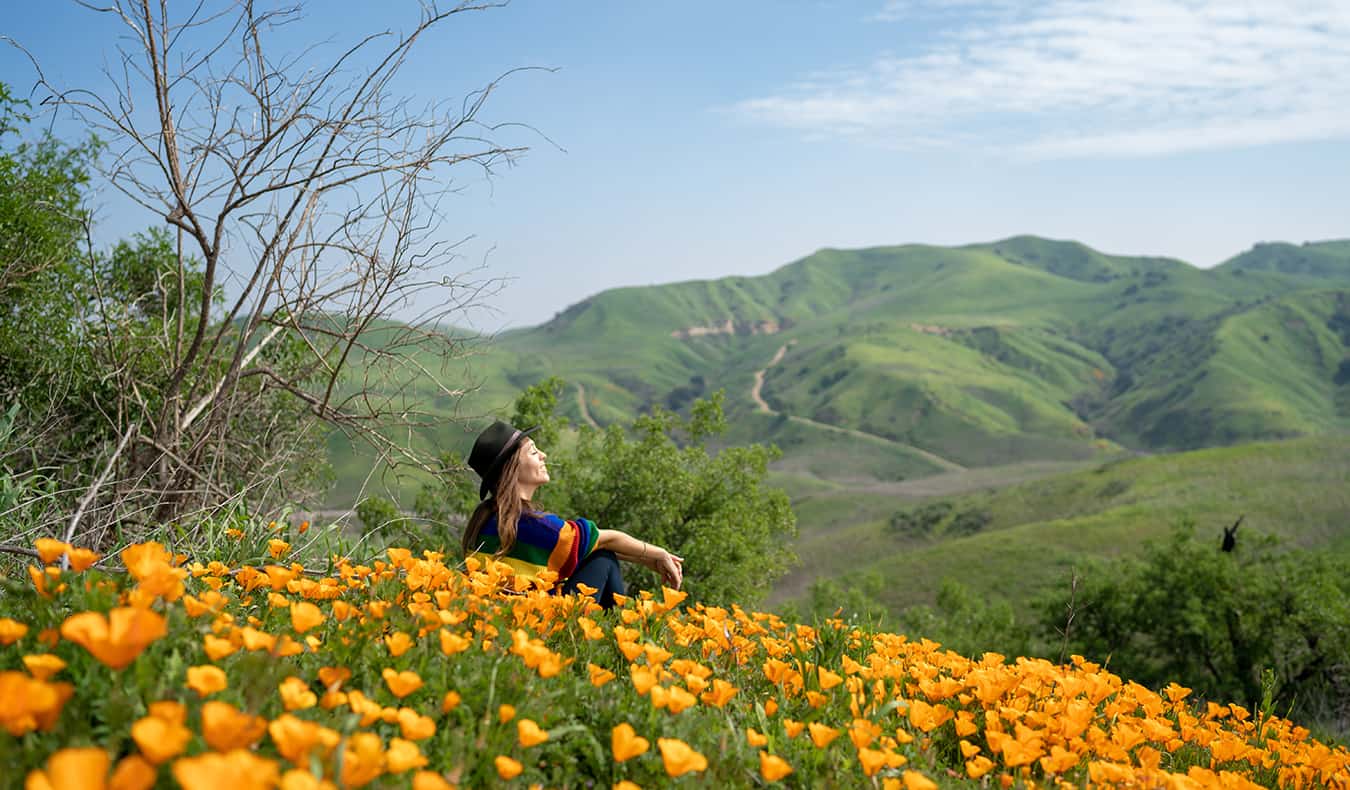
Personally, it’s tempting to cancel even if it’s something fun that I honestly want to do. If I didn’t prebook things in life, I’d never exercise, dive, or explore. It would be too easy to keep putting them off.
For example, I booked an island excursion on Nusa Penida and a cooking class in Chiang Mai, and led a group hiking tour of Torres del Paine in Patagonia that the women participants prepaid for. Many of them tended to be more introverted, but in a group activity like that, other solo travelers tend to show up, which helps everyone to be more social and open.
I’ve also found that staying in an accommodation that is social by nature, like a yoga or meditation retreat, or heading to places that are known for an activity I love, like scuba diving in Indonesia, can make my introversion easier to handle. Knowing that the others there will also be into the activity that I’m into gives us common ground, something to talk about, and the activity itself allows us to bond over a week or two. Some of my favorite people are those whom I met on a dive boat or week of deep spiritual practice.
Though all of these are “hacks” for becoming a more extroverted traveler, we introverts tend to get our energy from time spent alone. At some point we need some “me” time — and this is why solo travel can be so wonderful. Part of the beauty of solo travel is the time that you get to spend with yourself. You won’t disappoint anyone by needing time alone, nor will you have to push anyone away or force yourself into an activity you’re not really feeling.

I used to get down on myself if I went a few days without meeting new people. I’d fret over moments that I felt I’d “wasted” by reading in bed or chilling out for the day. Now I realize how important those days are too. I get to recharge by taking it easy and practicing self-care. And that’s a big reason why we travel too, isn’t it? We want to treat ourselves.
So please don’t feel bad if you’re traveling and you just don’t feel like going out that day, don’t want to be social, or feel like getting room service. It’s okay to do those things if it’s what you feel you need.
Listening to yourself is the most important part of solo traveling, anyway. This is something I’ve learned as a solo traveler in my 30s, and it’s made me enjoy traveling even more.
Knowing that you’ll have dopamine on your side, that you will meet people more easily on the road, and that you’ll be able to make real-time decisions about what’s best for you, you’ll be better off making the leap and traveling solo.
Conquering Mountains: The Guide to Solo Female Travel
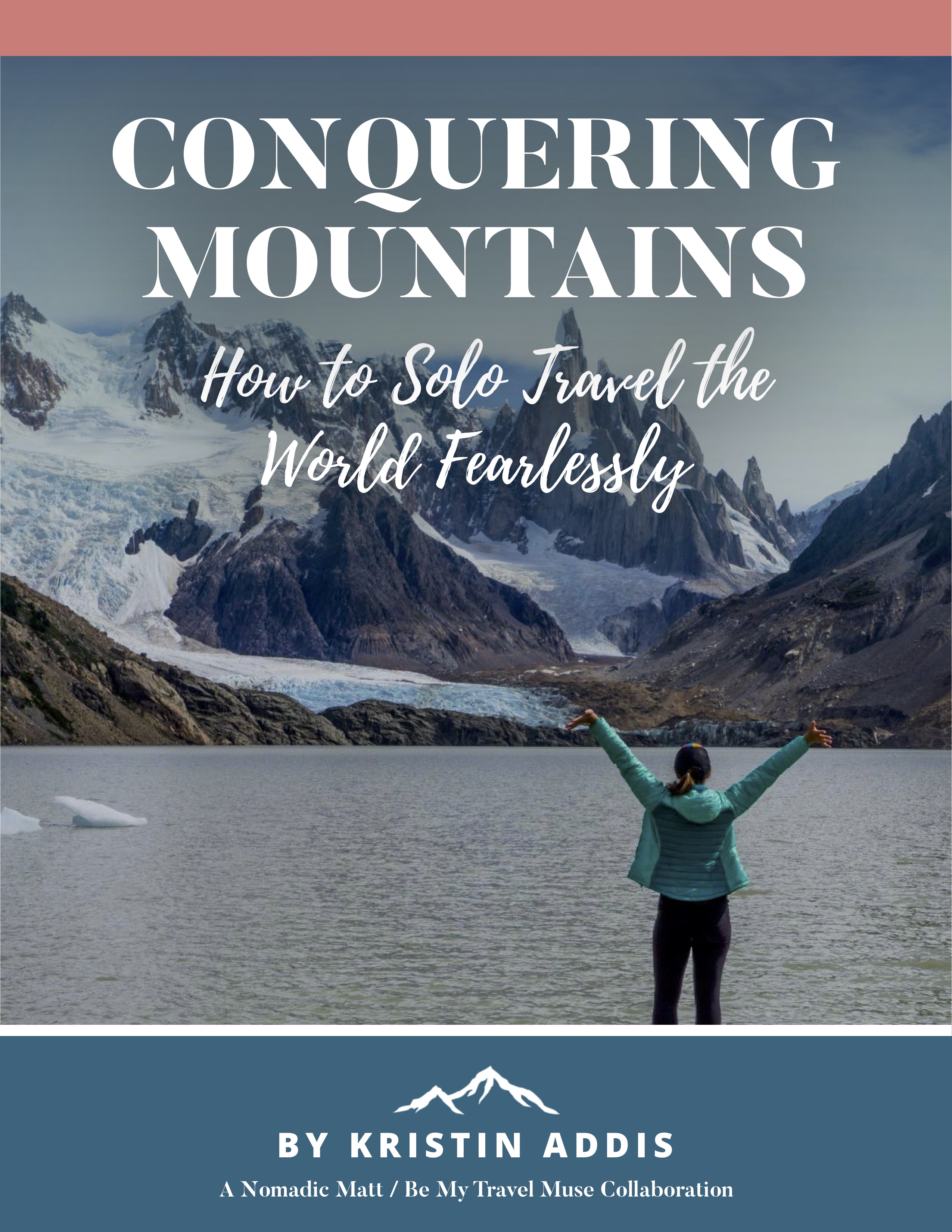 For a complete A-to-Z guide on solo female travel, check out Kristin’s new book, Conquering Mountains. Besides discussing many of the practical tips of preparing and planning your trip, the book addresses the fears, safety, and emotional concerns women have about traveling alone. It features over 20 interviews with other female travel writers and travelers. Click here to learn more about the book and start reading it today!
For a complete A-to-Z guide on solo female travel, check out Kristin’s new book, Conquering Mountains. Besides discussing many of the practical tips of preparing and planning your trip, the book addresses the fears, safety, and emotional concerns women have about traveling alone. It features over 20 interviews with other female travel writers and travelers. Click here to learn more about the book and start reading it today!
Kristin Addis is a solo female travel expert who inspires women to travel the world in an authentic and adventurous way. A former investment banker who sold all of her belongings and left California in 2012, Kristin has solo traveled the world for over four years, covering every continent (except for Antarctica, but it’s on her list). There’s almost nothing she won’t try and almost nowhere she won’t explore. You can find more of her musings at Be My Travel Muse or on Instagram and Facebook.
Book Your Trip: Logistical Tips and Tricks
Book Your Flight
Find a cheap flight by using Skyscanner or Momondo. They are my two favorite search engines because they search websites and airlines around the globe so you always know no stone is left unturned.
Book Your Accommodation
You can book your hostel with Hostelworld as they have the largest inventory. If you want to stay somewher eother than a hotel, use Booking.com as they consistently return the cheapest rates for guesthouses and cheap hotels. I use them all the time.
Don’t Forget Travel Insurance
Travel insurance will protect you against illness, injury, theft, and cancellations. It’s comprehensive protection in case anything goes wrong. I never go on a trip without it as I’ve had to use it many times in the past. I’ve been using World Nomads for ten years. My favorite companies that offer the best service and value are:
- World Nomads (for everyone below 70)
- Insure My Trip (for those over 70)
Looking for the best companies to save money with?
Check out my resource page for the best companies to use when you travel! I list all the ones I use to save money when I travel – and I think will help you too!
The post Can Introverts Successfully Travel Solo? appeared first on Nomadic Matt's Travel Site.
Backpacking Cambodia: 3 Suggested Itineraries for Your Trip

Posted: 5/1/2019 | May 1st, 2019
Cambodia: it’s full of warm and friendly people, beautiful coastlines, and lively nightlife, and it has a growing foodie scene. It’s also one of the cheapest countries in the world.
I didn’t have high expectations when I first visited in 2006. Back then, all I knew about Cambodia was its awful history involving the Khmer Rouge and that it was home to Angkor Wat.
But I was blown away by the people and their warmth, spirit, and hospitality; the beautiful natural scenery; and the country’s long history. It was wonderful, and I ended up staying weeks longer than I thought I would (I especially loved Phnom Penh). I returned often, including spending over a month there when I was writing my first book. (It made for a great base of operations.)
In the last decade or so, Cambodia has grown by leaps and bounds. Sleepy little towns I visited before are now megacities, tourists (especially Russians and Chinese) visit en masse, there are more ATMs (there was exactly one in the country when I first went), and there’s a growing expat and foodie scene.
Cambodia still has problems, but it’s a lot more cosmopolitan today than when I first went.
What should you do when you visit Cambodia?
How should you plan your trip?
Below are some itineraries that include the best destinations in Cambodia. You can use them as a guideline to help you make the most of your trip!
What to See and Do in Cambodia: A One-Week Itinerary
Day 1 – Phnom Penh
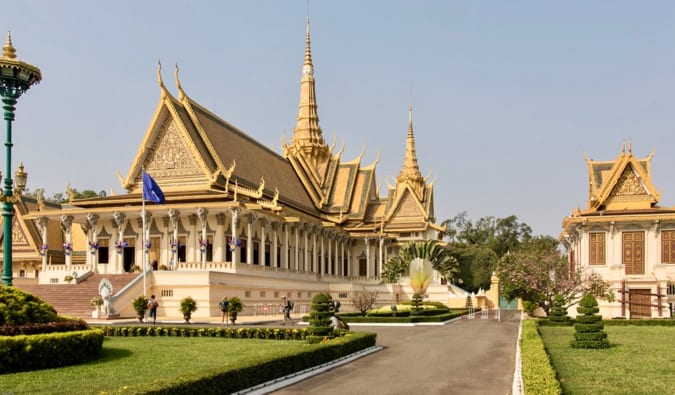
The capital of Cambodia, Phnom Penh has a Wild West ambiance, with dusty streets and a “devil may care” atmosphere. It has a few good attractions and an up-and-coming foodie scene.
The main attraction is the Royal Palace. Start there, and don’t miss the beautiful flower gardens and the Silver Pagoda, whose floor is made up of more than 5,000 silver tiles; inside is an emerald-covered Buddha and a diamond-covered Maitreya Buddha. It also has murals around its outer wall that tell the story of the Ramayana.
On the palace grounds are five stupas, with the two largest to the east containing the ashes of King Norodom and King Udung (the two most famous kings of modern Cambodia) and a statue of King Norodom on horseback. Admission is $10 USD for foreigners.
After seeing the palace, learn about the country’s tragic, not-too-distant history. The Tuol Sleng Genocide Museum is a former school where the Khmer Rouge interrogated and tortured people in the 1970s. You’ll see rusty beds and torture devices, in sharp contrast to the beautiful trees and lovely jasmine smell in the gardens. Admission is $5 USD for adults and $3 USD for anyone under 18.
Afterward, head to the Killing Fields, about 14km from Tuol Sleng. Although a visit to Choeung Ek (the best-known site) may not be the most cheerful way to spend an afternoon, it makes for a hallowed and memorable experience, a testament to the dangers of uncontested power. You won’t believe the memorial building in the center that is filled with skulls. Admission is only $3 USD; expect to pay at least $15 USD for a return-trip tuk-tuk ride.
(Tip: Visit the museum before heading to the Killing Fields, as it will open your eyes to the atrocities that happened here.)
Where to Stay in Phnom Penh: Sla Boutique Hostel – This is a pretty nice hostel not far from restaurants, bars, and attractions. It’s clean, and the beds are comfy and have privacy curtains. The staff (especially Mr. Star) are super friendly, and they can really help you plan your trip.
Day 2 – Phnom Penh
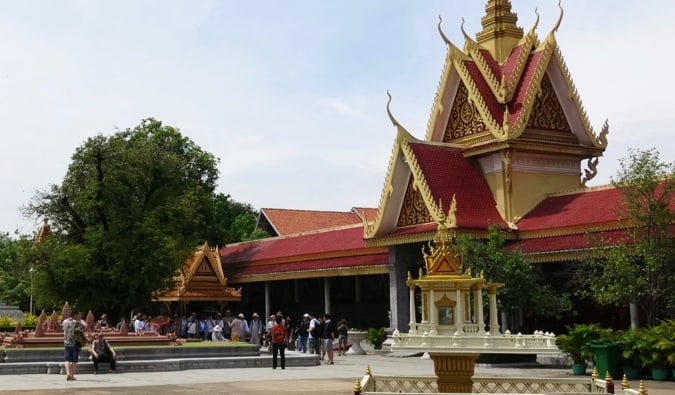
Spend your second day wandering around the city, and start by seeing the Independence Monument, designed by architect Vann Molyvann and inaugurated in 1958. It was created to mark Cambodia’s independence from French rule, though it also serves as a de facto war memorial. It’s one of the biggest landmarks in the city and a good place to start your day.
If you’re in the city on a weekend, try to catch an architectural walking tour with KA Tours, which has excellent guides who are students or experts in architecture, plus they’re not very expensive, around $15.
Check out the Cambodian Living Arts Center, a traditional dance school and performance center where you can watch students in training and see traditional live theatre. This is a fun way to spend a couple of hours while learning about the artistic traditions of the country. You can also take part in a workshop, which last around 90 minutes and cost $15 USD per person.
Make sure you stroll along Sisowath Quay on the Mekong River. The 3km walkway is busy and full of restaurants, bars, cafés, and shops.
Day 3 – Sihanoukville
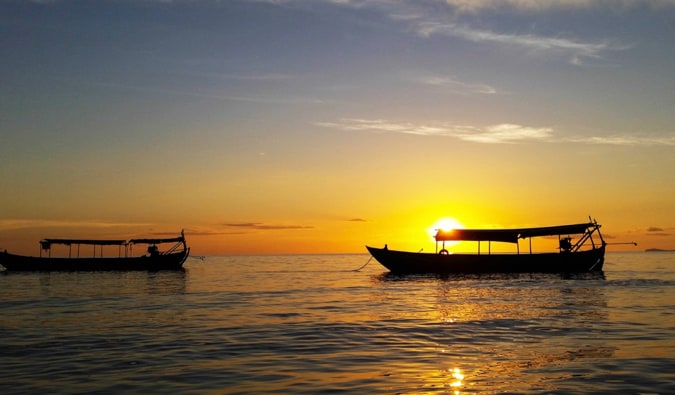
Get an early start and take a five-hour bus ride to Sihanoukville, named after the ruling prince of Cambodia in 1964. It was a lazy beach town until about 2010, when it took off with travelers (and tons of Chinese and Russian tourists on package tours) because of its white-sand beaches, nearby deserted islands, excellent diving, and delicious seafood. Its varied nightlife filled with cheap booze makes it the premier backpacker party city in Cambodia.
If you’re looking to soak up some sun, Independence Beach and Otres Beach are probably your best bets. Serendipity Beach used to be a great party spot, but there’s a lot of Chinese development going on now, so I wouldn’t stay there.
Where to Stay in Sihanoukville: Monkey Republic – This hostel is awesome. It’s a happening place, with a bar, restaurant, and pool. The staff is really friendly, and they host a lot of events. (Say hi to Aaron for me!) They can also organize a lot of day trips for you too.
Day 4 – Sihanoukville
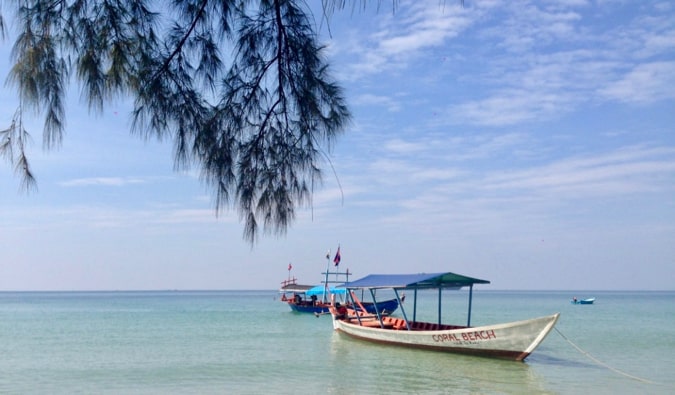
Today is a day for day trips.
From Sihanoukville, hop on a boat and take a 45-minute ride to Koh Rong. While you can stay overnight, if you’re pressed for time, you can do it in a day trip. The beaches here are way better than on the mainland (and a lot less polluted). Snorkeling day trips cost approximately $21 USD and include lunch and equipment; there are PADI-certified schools in the area that offer a variety of different dive trips for one or more days.
If you don’t feel like heading to Koh Rong, you could book motorbike trip into Bokor National Park (as well as longer, multiday trips if you’re interested). There, you can hike through a great rainforest or see the atmospheric ruins of the French aristocracy for whom Bokor was a big draw back in the day. You’ll have some amazing views and find ruins, waterfalls, and temples all around.
You could also do a day trip to Kampot and the pepper fields in that area too.
Day 5 – Siem Reap
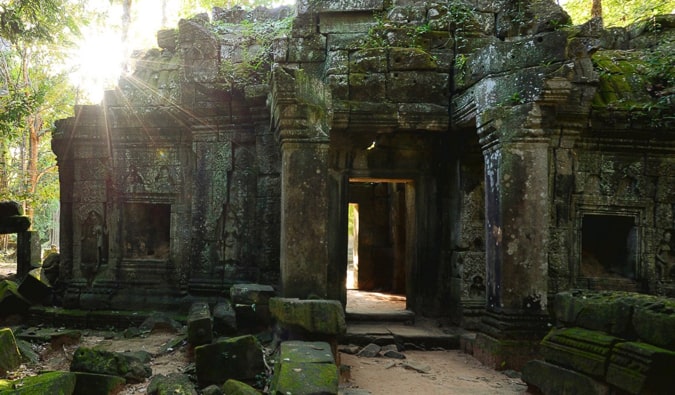
It’s gonna be a busy travel day. From Sihanoukville, you’ll need to return to Phnom Penh and then get on another bus to Siem Reap. I recommend Capitol Tours. It’s a 12-hour ride, so it’ll be evening by the time you get to Siem Reap.
(Note: It’s better to take the night bus so as not to waste a day. You won’t sleep well, but you also won’t lose a day!)
Siem Reap is located on the northeastern side of Tonle Sap Lake and is the main access to Angkor Wat. The center remains a rural old town, with French-style houses and shops. The area around the Old Market is crowded with locals and foreigners all day long.
Where to Stay in Siem Reap: Topsky Hostel – This hostel offers basic accommodations in a pretty quiet area that’s not far from the action. Try to get a lower bunk with a privacy curtain. The friendly staff will help you arrange a tuk-tuk and activities too.
Day 6 – Siem Reap
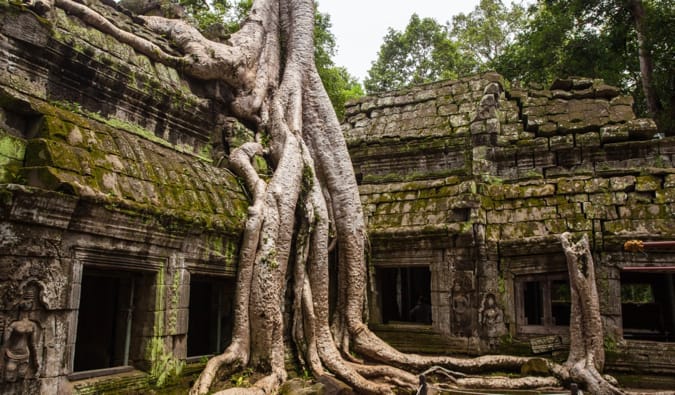
Spend your day at Angkor Wat, the ancient city that was the center of the Khmer Empire that once ruled most of Southeast Asia. The temple was built in the 12th century and covers over 500 acres.
The most popular temples are Angkor Wat, Bayon, Ta Phrom, and Angkor Thom. I would recommend getting a multiday pass so you can visit some of the outer temples where there are fewer visitors. You can hire a tuk-tuk for the day for around $20-25 USD or rent bicycles and explore on your own.
Angkor Wat is open daily from 5am to 6pm. Admission is $37 USD per person for a day pass, $62 USD for a three-day pass, and $72 USD for a seven-day pass.
Day 7 – Siem Reap
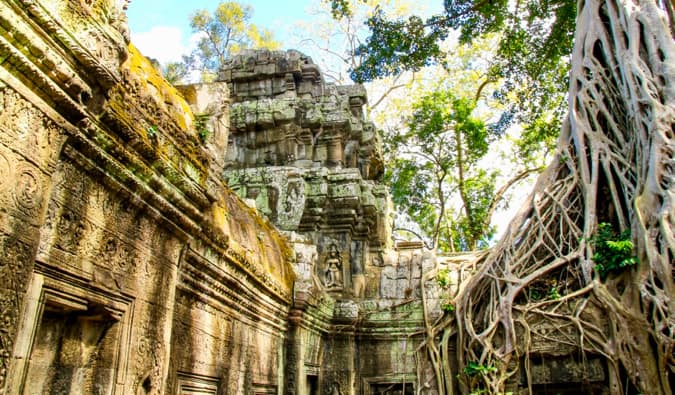
Enjoy your last day in Cambodia by exploring more of the Siem Reap area. Head over to the Angkor Wat complex for several more hours in the morning and then head over to astonishing Banteay Srei.
Known as “the city of women,” this temple was dedicated to the Hindu god Shiva and features a number of outstanding red sandstone statues. (You need an Angkor Wat Pass to visit.)
If you have time, visit Tonle Sap, Southeast Asia’s largest freshwater lake. It is 52km (32 miles) from Siem Reap. Sailing down the river and around the lake gives you a look at how closely Cambodian life is tied to this major waterway. Tours start around $2.50 USD per person.
What to See and Do in Cambodia: A Two-Week itinerary
Want to spend more time in Cambodia? Great! You should! There are tons of other places to visit. Here are my suggestions:
Days 1 & 2 – Phnom Penh
Follow the Phnom Penh itinerary from above.
Day 3 & 4 – Sihanoukville
Follow the Sihanoukville itinerary from above.
Day 5 & 6 – Koh Rong

Head out to Koh Rong, which got its name after the legend of a giant King Kong–like ape that once called the island home. It’s a 45-minute trip from Sihanoukville and a great place to relax on the beach or go snorkeling. There are a lot of accommodation options, and it’s a popular spot with backpackers.
Day trips costs around $25 USD and include lunch and snorkeling equipment, but since you have the time, spend a few nights here relaxing and enjoying beach life.
There are also other islands nearby if you want to stay longer and explore, including Koh Rong Samloem, which is becoming something of a backpacker paradise (there’s even a Full Moon Party there now).
Days 7 & 8 – Kep

In the morning, travel by bus to Kep, which is about two hours from Sihanoukville. This quaint beach town and fishing village is the quiet version of Sihanoukville: a nice place to relax near the ocean but without a party atmosphere. It’s famous for its pepper crab and empty beaches.
Consider taking two full days here. Sure, it’s quite sleepy and there’s not a lot to do, but it’s the perfect place to relax, eat all the delicious crabs the city is famous for, and read a book. You can also spend some time on nearby Rabbit Island (Koh Tonsay) too, a secluded and charming escape from the world if you’re looking to disconnect. Basic bungalows can be rented for under $10 USD per night.
Where to Stay in Kep: Khmer House Hostel – Kep is pretty spread out, so wherever you stay, make sure you rent a bike or scooter. This hostel is a good option as it’s not far from the Crab Market.
Day 9 – Kampot
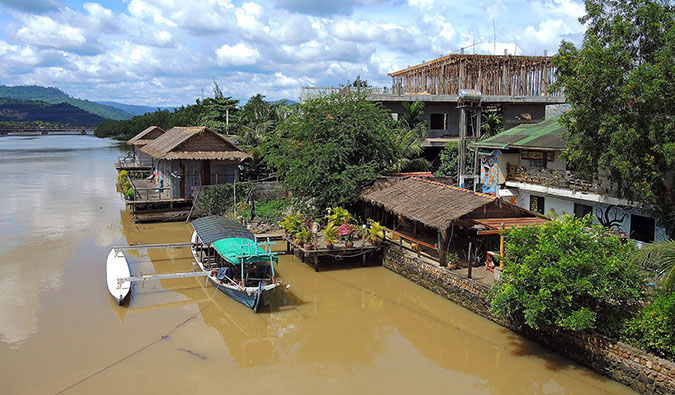
The southern region of Cambodia is filled with pepper farms where you can learn about the history of the spice, see how it is grown, and pick up what is considered some of the finest pepper in the world.
I’d spend one night in Kampot. It’s another quiet town on the coast. Most people come here to enjoy the scenic riverside views as well as the rolling hills that surround the city. The area used to be a getaway for the French, so you’ll see old French architecture around.
At night, the street near the old bridge is lined with fruit shake vendors. Try a million. The city is famous for them.
Also, if you only do one thing in this entire itinerary, make sure it’s eating the ribs at The Rusty Keyhole. They are some of the best ribs I’ve ever had in my entire life. You have to order them the day before. You’ll also get healthy side of mashed potatoes and coleslaw too. It’s one of the best meals I’ve ever had. I still dream of it.
Where to Stay in Kampot: The Magic Sponge – This is one of my favorite hostels in Cambodia. Make sure you book early, as it tends to sell out. It’s a really nice, relaxed guesthouse where you’ll get your own bed (not a bunk). You’ll feel at home here, and it’s a short walk to the center of town. The dorm rooms are very clean. They also have a little mini-golf course too.
Day 10 – Kampot
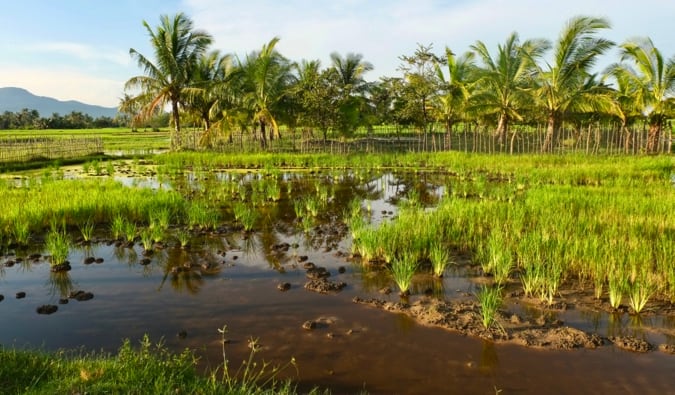
Today, hire hire a tuk-tuk driver to explore the Kampot area. The Phnom Chhngok Cave Temple has a religious shrine inside, or you can head out and spend the day in Bokor, as Kampot is relatively close to the park.
Days 11, 12, & 13 – Siem Reap
Follow the Siem Reap itinerary from above. Angkor Wat is best seen slowly, so use your days to explore it as much as possible. There are a lot of out-of-the-way temples to visit that are free of crowds.
Day 14 – Siem Reap

On your last day in Cambodia, why not take a cooking class? The class sizes tend to be around six people, and you will learn to prepare three different meals, as well as get recipe cards at the end. Prices start around $20 USD per person; local guesthouses can help arrange a class.
What to See and Do in Cambodia: A Three-Week Itinerary
Have even more time for Cambodia? Good! Cambodia has a lot more to it than the major spots on the backpacker trail.
Days 1, 2, & 3 – Phnom Penh and Kirirom National Park
Follow the above suggestions, but also head out to Kirirom National Park for a day trip. This park has all sorts of walking trails, mountain biking trails, waterfalls, and a few lakes. It’s a good place to go to take a break from the city.
The park is around a two-hour drive from the city, so you’ll need to hire a driver for the day. The best way to do this is to find some travelers to join you so you can share a ride, which will cost around $80 for the day.
Days 4, 5, 6, 7, & 8 – Sihanoukville and the Islands
Follow the above suggestions but at a much slower pace!
Days 9, 10 & 11 – Kep and Rabbit Island
Follow the above suggestions for Kep, but head out to Rabbit Island for a rustic island getaway.
Days 12 & 13 – Kampot
Follow the above suggestions!
Days 14, 15, & 16 – Siem Reap
Follow the above suggestions!
Day 17 – Koh Ker

For a fun day trip from Siem Reap, head to Koh Ker, located around 2.5 hours from town. Koh Ker was briefly the capital of the Khmer Empire, and many of the temples here are over 1,000 years old. It’s a massive archeological site located in the jungle, and it sees far fewer tourists than Siem Reap.
There are no public buses that go there (the roads were only paved a few years ago), so you’ll have to arrange transportation via your hostel or hotel.
Day 18 – Phnom Kulen

For another fun day trip, head to Phnom Kulen, considered the country’s most sacred mountain. It’s located just 50km from Siem Reap and offers some amazing jungles, hiking, and picturesque waterfalls where you can take dip to beat the heat. You can easily spend a day here. If you head up to the summit, there are some great views as well as a large reclining Buddha statue. Try to arrive early as the park fills up by lunchtime. Admission to the park is $20 USD.
Day 19 – Battambang

From Siem Reap, you can take a three-hour bus to Battambang. Or try taking a riverboat on Tonle Sap for a unique experience (there is one boat per day, with tickets costing around $20 USD per person).
When you arrive, you’ll discover Cambodia without the tourism. Get familiar with Battambang by exploring the town on foot (or by tuk-tuk). Check out the Phsar Boeung Choeuk and Phsar Naht markets. You’ll also want to visit the gorgeous pagodas and temples, such as Wat Pippitharam (near the Old Market), Wat Bovil, Wat Kandal, and Wat Damreay Sar.
In the evening, check out the Battambang Circus. The show is put on by students at a Cambodian nonprofit arts school, so your donations go to a good cause.
Where to Stay in Battambang: Sophea Hostel – This is a good place to meet locals and make some friends. It’s family-run, and they try to make you feel at home. The facilities are pretty basic, but typical, dorms. There’s a nice garden and sitting area. While there’s no restaurant on-site, there are plenty of nearby options.
Day 20 – Battambang
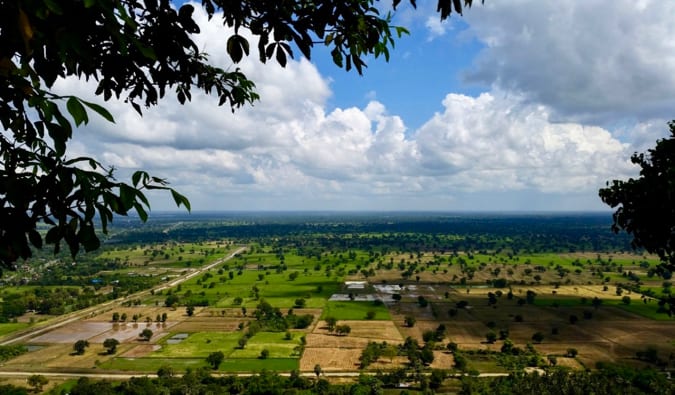
Take it easy this morning by touring the town a bit more on foot. Check out the colonial architecture along the waterfront and the governor’s residence. This building from the early 1900s is not open, but you can marvel at the exterior.
While you’re wandering, don’t miss the Art Deco central market building and the Victory swimming pool (where you can take a dip if you’re in the mood). You may want to visit the Battambang Museum; admission is just $1 USD, and you’ll learn a lot about the history of the area.
After lunch, you should grab a tuk-tuk and head a bit out of town to check out Phnom Sampeu. Take about an hour to climb to the monastery on the hill. You’ll also find some caves in the area with Buddhist temples in them. There’s also another cave at the foot of Phnom Sampeu; this is where you want to be around dusk, when millions of bats fly out of the cave in search of food. It’s an incredible sight!
Day 21 – Siem Reap or Phnom Penh
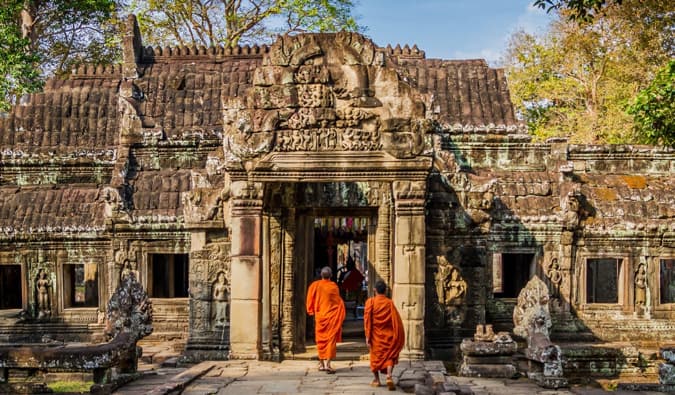
Make your way back to one of these towns, depending on where your flight is leaving from. Enjoy the bus ride, knowing it’s your last in Cambodia (at least for now)!
I always love my time in Cambodia. It lacks the polish of Thailand, making travel here a little more rustic and challenging.
But more amazing than any of the country’s sights and activities are the people. I’ve always found them to be incredibly welcoming. Even with so much darkness clouding their recent history, Cambodians always go above and beyond, making any trip here a memorable one.
But don’t take my word for it. Come and see this incredibly country for yourself.
And let these suggested Cambodia itineraries help you plan your trip!
Book Your Trip to Cambodia: Logistical Tips and Tricks
Book Your Flight
Find a cheap flight by using Skyscanner or Momondo. They are my two favorite search engines because they search websites and airlines around the globe, so you always know no stone is being left unturned.
Book Your Accommodation
You can book your hostel with Hostelworld. If you want to stay somewhere other than a hostel, use Booking.com as they consistently return the cheapest rates for guesthouses and cheap hotels. I use them all the time. My favorite places to stay are:
- Sla Boutique Hostel (Phnom Penh) – This is a classy hostel not far from restaurants, bars, and attractions. It’s clean, and the beds are really comfy!
- Topsky Hostel (Siem Reap) – This hostel is in a quiet area and offers basic accommodation. The staff will help you arrange a tuk-tuk and activities.
- Monkey Republic (Sihanoukville) – This hostel is a happening place and always good for a aprty. They have a bar, restaurant, and pool making it really easy to realx and meet people. The staff is really friendly, and they can also organize some day trips for you too.
- Sophea Hostel (Battambang) – This is a family-run hostel and they doo a good job of making you feel at home. The facilities are basic but there’s a nice garden and sitting area. While there’s no restaurant on-site, there are plenty of nearby options.
Don’t Forget Travel Insurance
Travel insurance will protect you against illness, injury, theft, and cancellations. It’s comprehensive protection in case anything goes wrong. I never go on a trip without it, as I’ve had to use it many times in the past. I’ve been using World Nomads for ten years. My favorite companies that offer the best service and value are:
- World Nomads (for everyone below 70)
- Insure My Trip (for those over 70)
Looking for the best companies to save money with?
Check out my resource page for the best companies to use when you travel! I list all those I use to save money, and I think they will help you too!
Want More Information on Cambodia?
Be sure to visit our robust destination guide on Cambodia for even more planning tips!
The post Backpacking Cambodia: 3 Suggested Itineraries for Your Trip appeared first on Nomadic Matt's Travel Site.